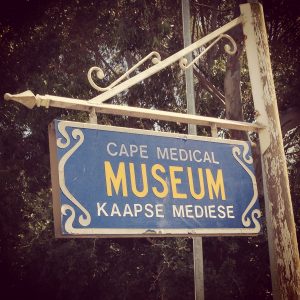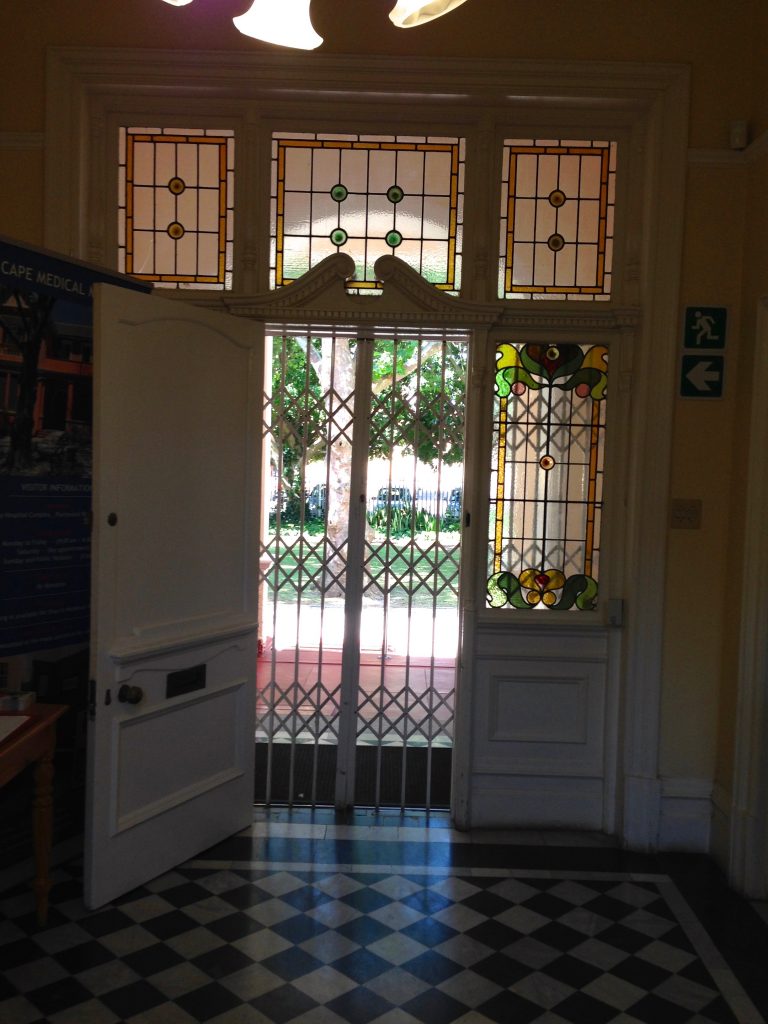I wrote a post for the Center for Historic Preservation’s blog, Southern Rambles, on the use of shipping containers in vernacular and high-style architecture. It emerged from my work in South Africa, and might be of interest to readers here. Please feel free to check it out here!
Tag: Cape Town
The Cape Medical Museum
The thing about researching and working on difficult heritage is that it is difficult for a reason. Part of why I planned such a lengthy research trip to South Africa was that I knew I’d be confronting a lot of serious, emotional topics and sites, and I wanted to have time in between these more intense experiences to recover. I wanted to be sure that when I visited a site, I wasn’t emotionally exhausted from an earlier visit elsewhere. I want to be a thoughtful, engaged visitor, and that means not shutting down because I’ve spent the last three days confronting the horror that human beings inflict on each other. With that in mind, I made a visit to the Cape Medical Museum in Cape Town.

The Cape Medical Museum does not have a website, and they are actually a bit tricky to find. I happened to see it when I rode past in a taxi, and knew that I absolutely HAD to visit. I have a pet interest in medical history, and I enjoy learning about the past through the lens of disease and medical practices. I love a good medical history book, especially when the writer explores the intersection between disease, science, culture, social history, and race. I listen to a lot of medical histories when I’m driving (not always the best idea if you don’t feel well), and right now I’ve been listening to Rabid: A Cultural History of Rabies, which I recommend highly.
Anyway! The museum is in an attractive but unassuming historic house in the Old Hospital Complex in Green Point, Cape Town. There is no admission fee (though I made a donation), and there are no guided tours. In addition to an extensive collection of medical machines and equipment, the museum includes a fantastic exhibit on various diseases that have invaded the region. The multilingual panels connect the facts of diseases like typhus and yellow fever to their impact on society. In a panel on the bubonic plague, for example, one section describes how the practice of quarantining Africans suspected of having plague in camps helped create the idea for townships under apartheid. One of these camps later became the site of the Nyanga township. Unfortunately, there was no photography in the museum, so you’ll just have to take my word for it.

The disease room also had a display case with small windows where visitors could look in and see some of the medical models physicians in training used to learn how to identify diseases like diphtheria and gonorrhea. Though these were not as elaborate as the casts and preserved parts I saw earlier this year at the Mütter Museum in Philadelphia, they still conveyed the horrifying commonness of these types of conditions.
There were several rooms dedicated to particular types of medical equipment, like dentistry and ophthalmology, and a few period rooms set up as an operating room, a dispensary, and a delivery room. These rooms also included display cases full of medical equipment from different time periods, which was both fascinating and a little disturbing. One of my favorite displays was a series of respirators/ventilators showing the evolution of that technology, and culminating with a 1960s-era Bird respirator.
If you do happen to find yourself in Cape Town, this little gem is well worth a visit. It’s an easy walk in Green Point or from the V&A Waterfront, and I spent about an hour and a half, which included reading all of the panels because that is how I roll.

Watch This Space
You may (or may not) have noticed that it’s been quite a while since I last posted here. All of my good intentions about continuing to blog have fallen to the wayside as I have been dedicating my writing energy to the dissertation and, more recently, the dreaded job application process. It’s been a productive summer. I have two chapters out for review with my committee, and a third has just undergone its first review with my supervisor, and I’ve even found some positions to apply for. But I didn’t decide to start blogging again to bore you with the details of my academic progress; I want to share some exciting news.

On September 28, I will embark on a six-week trip to Johannesburg and Cape Town, South Africa to conduct research for my dissertation. I will be meeting with a few contacts, visiting historic sites, taking tours, and trying to remind myself that this is in fact real life. This trip has been in the planning stages for a long time, and it’s hard to believe that it’s actually finally happening. In order to make the most of my time, I will be blogging more actively from South Africa, mostly site reviews and observations about the heritage landscape. I’m even renting an iPhone while I’m there to make it even easier to document my trip! (Yes, I am one of those Luddites clinging desperately to a flip phone.)
So… watch this space!